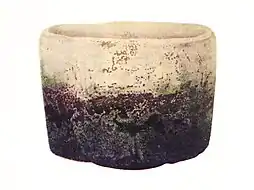The Six Ancient Kilns (六古窯 Rokkoyō) is a category developed by Koyama Fujio (小山富士夫 1900–1975) in the post-war period to describe the most noteworthy ceramic kilns of Japan.[1]
The six kilns are:[2]
- Bizen ware (備前焼, Bizen-yaki), produced in Bizen, Okayama
- Echizen ware (越前焼, Echizen-yaki), produced in Echizen, Odacho and Miyazaki, Fukui Prefecture
- Seto ware (瀬戸焼, Seto-yaki), produced in Seto, Aichi Prefecture
- Shigaraki ware (信楽焼, Shigaraki-yaki), produced in Kōka, Shiga, east of Lake Biwa
- Tamba ware, also known as Tachikui ware (丹波立杭焼, Tamba-Tachikui-yaki), produced in Sasayama and Tachikui in Hyōgo
- Tokoname ware (常滑焼, Tokoname-yaki), produced in Tokoname, Aichi Prefecture
The Okayama Prefectural Bizen Ceramic Museum held an exhibition in 2001 about the six kilns.[3]
See also
References
Journey. One thousand years. The Six Ancient Kilns -JAPAN HERITAGE-
External links
This article is issued from Wikipedia. The text is licensed under Creative Commons - Attribution - Sharealike. Additional terms may apply for the media files.

